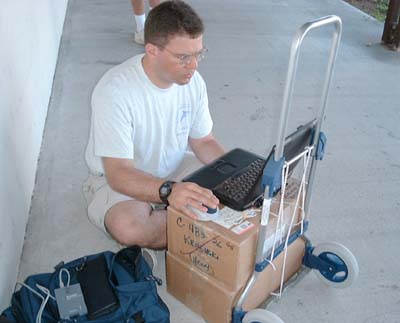Journal Entry
July 17th. & 18th.
Greg "Gator" Brunshidle - Assistant Photographer
For the avid scuba divers who have been following our expedition journals, I apologize for the lack of underwater activity in this entry. The fact is that even documentaries that primarily deal with the underwater world need to have coverage of surface sites and activity. Well, the last two days have been spent developing specialized equipment for surface shooting and deploying and testing that equipment. I have to admit though that personally, the time off the water has been good for me and allowed my severe sunburn to recover.
| Jonathan and Mark shoot scenes of the surf in the hot sun of Red Beach two, a historic spot where the U.S. military stormed the Japanese. Mark is monitoring audio and directing the "shotgun" microphone. Because the audio guy has to wear the sweaty headphones, nobody particularly likes the job! |  |
The morning of the 17th began with a book signing featuring Mark Miller, this expedition's Historical Expert and Jonathan Bird, our Director of Photography. The book signing allowed Kwajalein residents to purchase personally signed copies of Miller's "In the Arms of the Sea" and Bird's "Beneath the North Atlantic." This brief respite from our shooting schedule also allowed me the opportunity to continue work on this website. During the book signing I added a new journal entry, updated the list of sponsors, and created some navigation .gifs.
 |
Gator
takes some time during the booksigning to work on the web page.
With a G3 laptop and a couple boxes of books, you too can design
a web page!
|
After the book signing, Bird and Expedition Leader Tom Krasuski finished work on a camera jib (a device that allows the camera to be raised and lowered without changing it's pitch, for smooth vertical moves). The jib helps make the most of Kwajalein's minimal topography. Part of the adventure in getting the jib working was finding the right parts to build it. Getting things, especially 12 foot long tubes, to remote islands is not easy, so parts of the jib were shipped in but the device was assembled using other parts scrounged from around the island, including some aluminum pipe and a few scuba weightbelts! McGuyver would be proud.
It was put to work successfully during an afternoon of exploratory surface shooting. Many artifacts of the battle for Kwajalein still remain. Along the shoreline are numerous defensive "pill boxes" and gun mounts. A low white fence surrounds a Japanese cemetery that is visited annually by families of the deceased. Offerings of saki, incense, candles, and flowers still remain from past visits.
| Mark, Jonathan and Tom visit the Japanese cemetary on Kwajalein. |  |
Not being able to resist the water for more than 24 hours when in such close proximity, Mark, Jonathan, and I were able to coerce Julio Rodrieguez and Bob Hatcher from the Kwajalein Scuba Club into taking us on one of their night shore dives. The site was beautifully prepared by the scuba club with the addition of steps leading down the rocks to the water and a parking area nearby. Even though this was planned as a "fun" dive, none of us feels comfortable diving without a camera in our hands; we each went prepared to capture whatever interesting subjects we might find. We dove a small Japanese trawler that sank in an upright position. On it we found yellow cup corals, butterfly fish, and a large friendly puffer who made Jonathan's acquaintance.
 |
Jonathan and Tom shooting at mid-day. The sun is so hot that we can only spend a few minutes at a time baking ourselves before we have to retreat to the shade to cool off! |
We spent the morning of the 18th. continuing our surface shooting with returns to several sites we had visited previously but had decided to delay shooting until we could take advantage of morning light. We also continued our exploration of the island, including scenic vistas from one of the radar dome platforms and Mount Olympus, a hill built to support the Raytheon TPN-19 radar site. This hill is the highest point in all of the Marshall Islands at a little over 100 feet.
Cliff Simoneau, Technical Diving Advisor to the expedition arrived this afternoon. Cliff has many years of experience in the scuba industry and currently serves as vice-president of Technical Divers International. He's a welcome addition to the team, having brought with him many technical "goodies" you'll be learning about in future journal entries. Most of the evening was spent updating Cliff of the wrecks we've explored and photographic and diving goals we hope to achieve. Cliff's arrival signals the end of our surface interval and the next entry should be all wet.


